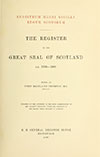

Polwarth Castle once stood halfway between the Polwarth village and Polwarth church. Nothing of it now remains.
The lands of Polwarth are first mentioned in charters of the early 13th century, at which time they are in possession of a family simply styled as “of Polwarth”. Whether or not they built an early castle is unclear, but likely.
When Sir Patrick de Polwarth died in the 14th century leaving no male heir, the barony of Polwarth passed to the Sinclair family upon the marriage of his only daughter, Elizabeth, to Sir John Sinclair of Herdmanston.
Their great grandson, another John Sinclair, died without a male heir, and while Herdmanston passed to his brother, Sir William Sinclair, his lands of Polwarth and Kimmerghame were split between his two daughters, Margaret and Marion.
Margaret Sinclair married Patrick Hume in 1451, and Polwarth passed into the Hume family. In 1521 Alexander Hume of Polwarth married Margaret Lauder, daughter of Sir Robert Lauder of the Bass and widow of Kentigern Hepburn of Waughton and Luffness.
The “towre of Pollerd” was burned by an English army led by Edward Seymour, Earl of Hertford, in September 1545, after which the Humes moved permanently to Redbraes Castle, possibly via Mains House first as “the towre of Red Brayes” was also burned in September 1545.
Whether or not the ruins remained in any form for some time afterwards is unclear, but on Robert Gordon’s map “A description of the province of the Merche”, published in the mid-17th century, there is a castle marked as Pollart. This is may represent the remains of Polwarth Castle, or it may represent Redbraes Castle which I have seen referred to in one source as Polwarth House.

All traces of the castle have now been long since cleared away. A slight mound topped with trees apparently marked the site of the castle as late as 1970, but today there are no trees in a gently rising field at the spot in question.
Alternative names for Polwarth Castle
Pollart; Pollerd; Polwart; Polwoart; Poulwrth














